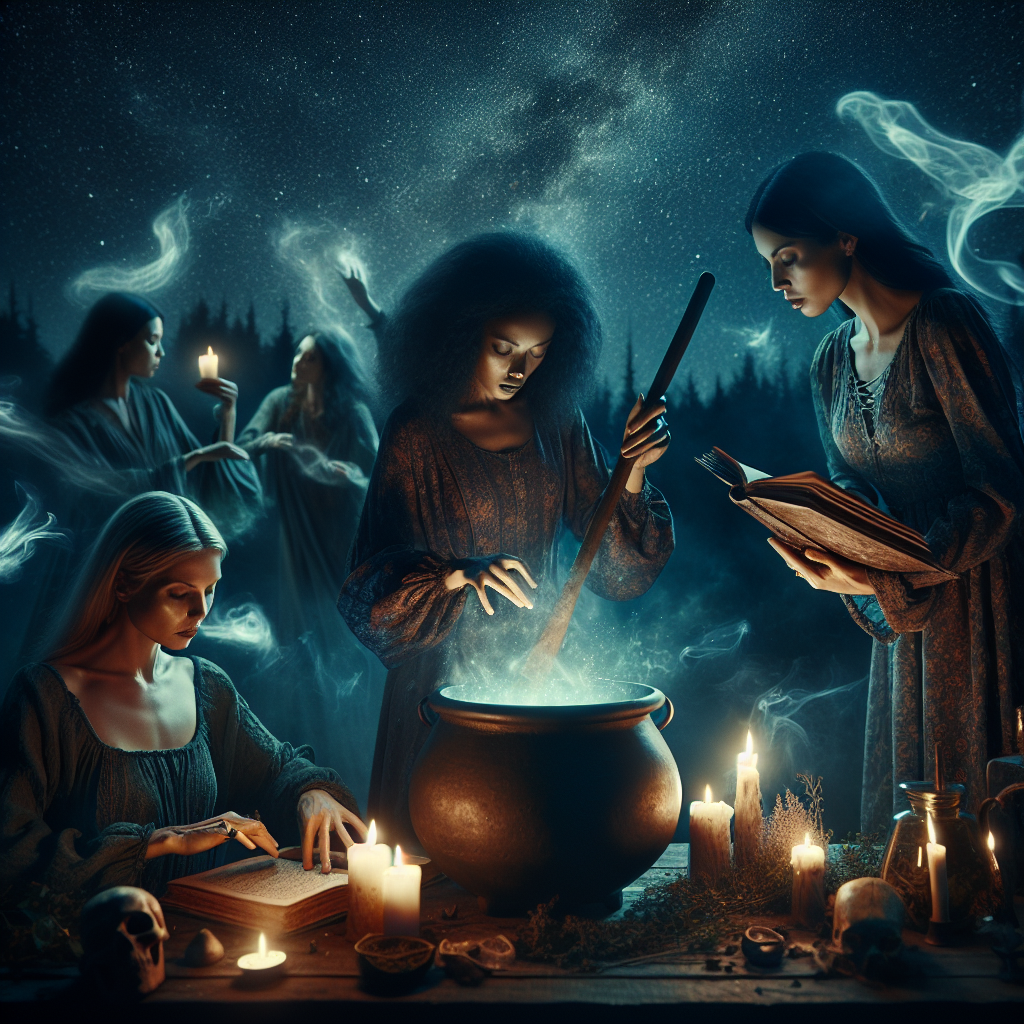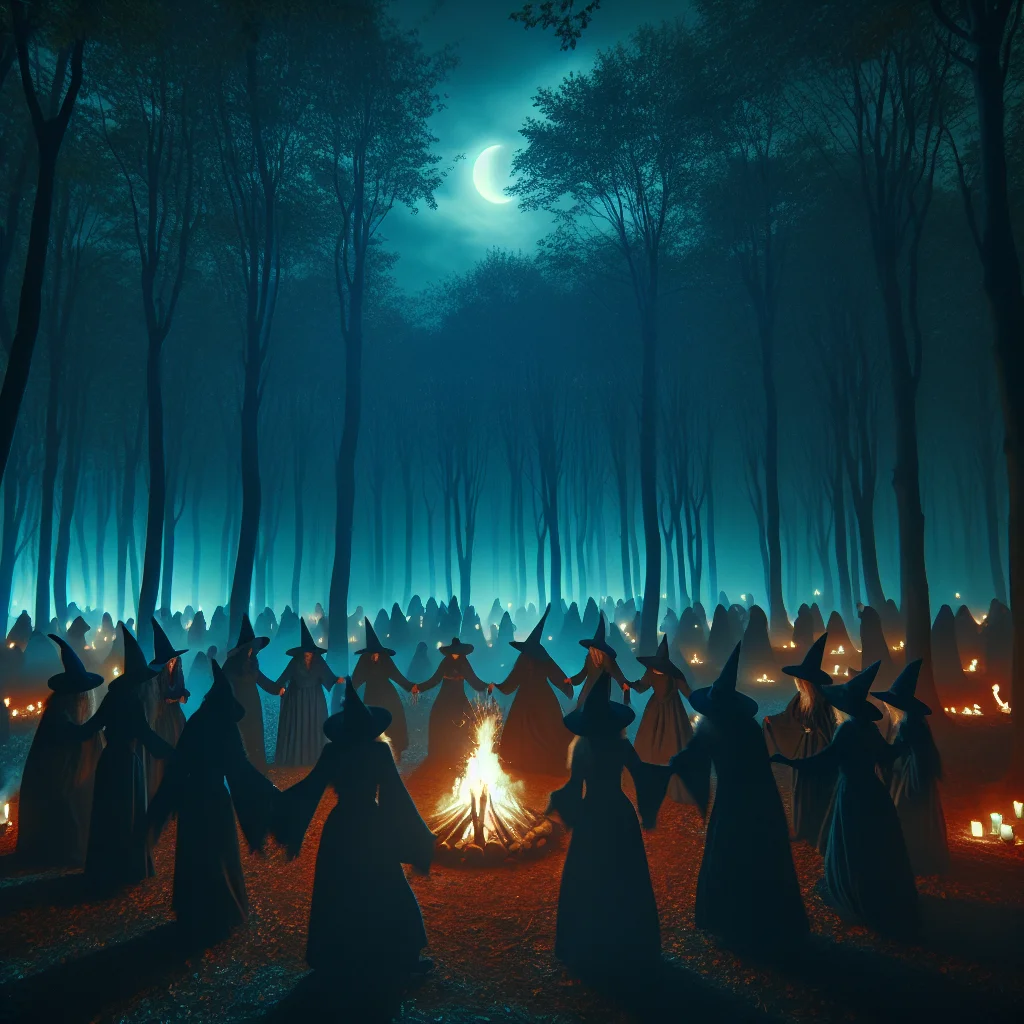As an Amazon Associate I earn from qualifying purchases.
The Witches’ Sabbath, a clandestine gathering of witches and sorcerers depicted in numerous tales and folklore, represents both fear and fascination inscribed in human consciousness about the unknown and the supernatural. These are nocturnal events thought to be dedicated to the worship of the devil, where participants were believed to engage in a variety of sinister rituals and orgiastic revelries.
The history of the Witches' Sabbath stretches far back into the earliest annals of human civilization, yet it still holds a significant presence in contemporary pop culture, literature, and film, signifying the enduring human interest and fear of the supernatural. The concept of a Witches’ Sabbath emerged during the Middle Ages, especially during the height of the European witchcraft trials. Folklore and tales of these gatherings predominantly originated from accounts by alleged witches themselves, most of whom were probably under duress or torture during the witch trials.
Despite its historical roots in fear and trepidation, the Witches' Sabbath has often been reimagined and appropriated in popular culture today. It is often depicted as a party-like gathering, usually held on significant dates such as All Hallows’ Eve or other Pagan holidays. The supposed attendees no longer only witches and sorcerers, but also wandering spirits, mythical creatures, and all manners of things that go bump in the night.
The secretive and nocturnal nature of the Witches’ Sabbath lends itself to many captivating interpretations. For instance, it's noteworthy that during the peak of the witch trials in the 16th and 17th centuries, more than 50,000 individuals were reportedly executed on charges of witchcraft in Europe alone. This shocking statistic portrays the deep-seated fear and paranoia of the era concerning the supernatural and unknown.
In more recent times, the Witches’ Sabbath took on a more symbolic meaning in the literary and visual arts. It serves as an allegory for subversive desires and antisocial behavior, reflecting the changing social and cultural attitudes toward the idea of witchcraft. Notoriously, the Witches' Sabbath features in Mikhail Bulgakov’s novel “The Master and Margarita,” where it is reimagined as a grand ball hosted by the devil, seen as a metaphor for the political and social chaos of the time.
Shrouded in intrigue and mystery, the narrative of the Witches’ Sabbath continues to adapt to the times. Today, it serves less as a symbol of fear, but more of intrigue and an exploration into the human fascination with the ‘unknown'. Whether it's a representation of subversive desires or a spawn of historical witch trials, the Witches' Sabbath continues to be a compelling component of cultural discourse, embodying the constantly evolving human concept of the supernatural.
What is the History and Celebration of the Mysterious Witches' Sabbath?
The Witches' Sabbath, a term shrouded in mystery, refers to a gathering of witches consorted by folk tales across various cultures. Its history traces back to the Middle Ages, where it was presumed that witches congregated to venerate the devil, leading to moral panic and subsequent witch hunts. The ‘celebration' aspect of the Witches' Sabbath is laced with controversy, as it is often depicted involving ritualistic practices, dances, feasts and sometimes perceived malevolent acts in popular culture and literature. But these representations are mostly mythic and the true history of Witches’ Sabbath is far more complex, nuanced, and tied to societal views on witchcraft and paganism. Explore further to unveil the intricate layers of the enigmatic Witches' Sabbath.
The witches' Sabbath, an arcane aspect of ancient European folklore, takes us back to the darkest corners of medieval history, a time when myth and reality were intertwined and the line between the spiritual and the mundane was blurred. The mystery surrounding these gatherings continues to intrigue scholars, fuel artistic interpretations, and influence pop culture.
The History of the Witches' Sabbath
Commonly believed to have taken root in the early medieval period, the witches' Sabbath is silk-woven into many strands of folklore across Europe. Originally, it was portrayed as a gathering of witches and other dark entities, often led by the Devil himself. Historically, these meetings were said to occur in remote and secluded places during the dark hours, particularly on the eve of certain pagan festivals and Christian holy days.
The mythology surrounding the witches' Sabbath encapsulates vivid accounts of nocturnal journeys on broomsticks or riding on animals, shape-shifting, indulging in orgiastic rituals, and even cannibalistic tendencies. Much of what we know about it is derived from accounts of witch trials, confessions obtained under torture, and demonology texts.
However, some contemporary historians argue that witches' Sabbath was more a fabrication of church authorities, used as an instrument to suppress pagan customs and to exert authoritarian control over female sexual expression and power.
The Celebration of the Witches' Sabbath
The celebration aspect of the witches' Sabbath has undergone considerable mutations over the centuries influenced by social, cultural, and religious evolutions. Today, it is largely symbolic and refers to the gathering of those who practice Witchcraft or Wicca, modern pagan, witchcraft religions. The participants meet under the full moon or during a sabbat, which falls on specific dates based on the Wheel of the Year in Paganism.
During these gatherings, they perform rituals, cast spells, honor the gods and goddesses, and celebrate the cycles of nature. The disturbing aspects that once defined the witches' Sabbath, such as engaging in immoral activities or worshipping the devil, have been largely discarded by these modern-day practitioners whose emphasis is often on healing, balance, and harmony with nature.
Influence on Culture and Pop Culture
The witches' Sabbath has had a significant influence on culture, literature, and the arts. It forms the basis of many great literary works, including Shakespeare's “Macbeth”, and artworks like Goya's “Witches' Sabbath”. In contemporary times, the concept has been appropriated in various forms of pop culture, including film, television, and music. For instance, the recent series “Chilling Adventures of Sabrina” extensively portrays the witches' Sabbath, albeit from a fictitious perspective.
It’s fascinating to observe how the perception and portrayal of witches' Sabbath has undergone radical transformations through the centuries, from being the feared nocturnal gathering of witches to becoming a symbol of feminine power and an ode to nature.
According to the Pew Research Center, while statistics related to the practice of witchcraft are hard to come by, in 2014, around 734,000 Americans identified as Wiccan or Pagan. Considering that these communities often incorporate elements of the witches' Sabbath in their rituals, the legacy of this ancient event continues to leave a profound impact, testament to its enduring allure and mystery.
1. Q: What is a Witches' Sabbath?
A: A Witches' Sabbath is a meeting of those who practice witchcraft and other rites. Traditionally, it's imagined as a large gathering where witches, led by the Devil, engage in a variety of rituals.
2. Q: When does the Witches' Sabbath typically occur?
A: The Witches' Sabbath is commonly associated with the eve of certain holidays, especially those prominent on the pagan calendar, such as May Eve (Walpurgis Night), Midsummer, and All Hallow's Eve (Halloween). However, it is not limited to these times and can, according to tradition, occur at any time.
3. Q: How did the concept of the Witches' Sabbath originate?
A: The concept of the Witches' Sabbath originated during the Middle Ages in Europe, particularly tied to Christian perceptions and fears of witchcraft. The image of witches meeting in secret to practice their rites became a significant part of witchcraft's mythos.
4. Q: Does the Devil play a crucial role in the Witches' Sabbath?
A: In traditional lore, the Devil is a vital figure in the Witches' Sabbath. He is imagined as leading the gathering in their various activities. However, in modern practices, focus on the Devil's role varies greatly among different witchcraft and pagan communities.
5. Q: Are there any rituals performed during the Witches' Sabbath?
A: Yes, numerous rituals are associated with the Witches' Sabbath, varying greatly based on sources and modern practices. These may include dances, feasts, spells, and more.
6. Q: Has the perception of Witches' Sabbath changed over time?
A: Yes, it has. Historically, the Witches' Sabbath was seen as a sinister gathering. But today, it's generally viewed as a time for witches to gather, celebrate, and perform rituals tied to pagan holidays, minus the ominous overtones.
7. Q: What is the role of the Black Mass in the Witches' Sabbath?
A: The Black Mass, traditionally, is a parody or inversion of the Christian Mass. Its association with the Witches' Sabbath stems from the belief that witches were inverters and mockers of Christian norms. However, its relevance in modern practices varies widely.
8. Q: How does modern witchcraft view the Witches' Sabbath?
A: Modern witchcraft views the Witches' Sabbath less as an alliance with the demonic, and more as a time for spiritual connectivity, celebration, and rites. It is not necessarily seen as a large, formal gathering, but rather a time of heightened spiritual activity.
9. Q: Can anyone attend a Witches' Sabbath?
A: Traditionally, only those initiated into witchcraft could attend a Witches' Sabbath. Today, however, individual practices may vary, and some witchcraft or pagan communities may welcome interested non-initiates to certain gatherings.
10. Q: Does the Witches' Sabbath have any connection to the Jewish Sabbath?
A: No, there is no connection between the Witches' Sabbath and the Jewish Sabbath. The use of the term ‘Sabbath' in Witches' Sabbath likely comes from its broad meaning of ‘a meeting or gathering.'

Conclusion
Throughout history, the Witches' Sabbath has been shrouded in mystery and intrigue. A significant point made in the article is how it is often closely linked to the worship of pagan deities, symbolizing a form of spiritual resistance against the dominant Christian order and providing a space for the marginalized and the oppressed to find their voices. The Sabbath was typically portrayed as a night-time gathering involving various deviant acts, a narrative pushed by witch hunters, resulting in a skewing of its actual purpose, which was more ritualistic and centered around fellowship and bonding among practitioners. Lastly, it offered an alternative spiritual pathway that challenged the patriarchal and often oppressive tenets of the Christian religion.
Though folklore and pop culture have often represented the Witches' Sabbath as purely sinister, modern interpretations encourage a more nuanced view. With the resurgence of pagan and witchcraft traditions, many today celebrate it in the spirit of reclaiming female power, showing solidarity, and reconnecting with nature. However, it is paramount to remember that the historical fear and subsequent persecution of witches were deeply rooted in sexism, classism, and a fear of the other. While the cultures and beliefs around the Witches' Sabbath have evolved over the centuries, the core principles of mutual respect, unity, and spiritual freedom continue to thrive on in contemporary pagan and Wiccan circles.
Amazon and the Amazon logo are trademarks of Amazon.com, Inc, or its affiliates.


